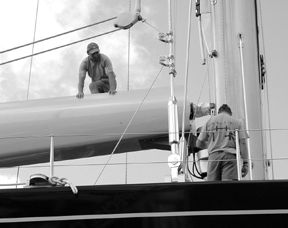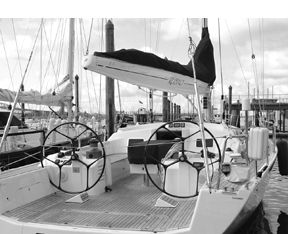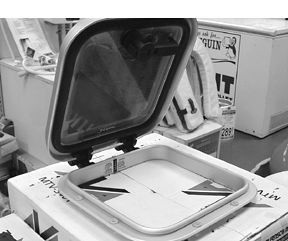With New Zealand’s yacht construction industry booming, it’s inevitable that associated industries such as sparmaking should enjoy parallel growth. New Zealand has long been a leader in composite construction of one-off boats for both racing and cruising. That same expertise, coupled with the advantage of a relatively low labor rate, has spilled over into the sparmaking sector in a big way.

Carbon Spars from New Zealand: Marten Spars and Southern SparsTwo of the New Zealand companies benefiting from this growth are Marten Spars and Southern Spars, cross-town rivals with global markets. The key to growth for both companies is the increasing demand for carbon fiber rigs for increasingly larger sailboats.
Carbon masts offer unquestioned advantages that increase in importance with the size of the boat. The decrease in weight aloft gained with a carbon mast can make the difference between success and failure for a project.
In the last 12 years or so, the strides in the development of carbon spars have been gigantic. This is not experimental technology. It is the mainstream for custom cruising boats over 55′ long, as well as for small one-design racers.
Carbon masts are still a labor-intensive operation, with many more hours going into the layup of the spar than are required to pull an aluminum tube. But the additional labor cost comes back in improved performance to a degree that makes the extra cost justifiable in a large percentage of cases.
For larger boats—over 55 to 60 feet—the cost differential between a carbon mast and a custom aluminum one decreases rapidly. Whether you’re racing or cruising, a larger sailboat will be a better boat with a carbon fiber mast. Integral reinforcements and fittings, reduced possibility for corrosion, greater resistance to cycling fatigue—all these factors combine with the primary advantage of decreased weight aloft to give carbon fiber spars the edge.
Even a small cruising boat can benefit from carbon fiber spars. The Kevlar-reinforced carbon fiber Hall Spars spinnaker pole we carried around the world on Calypso was less than half the weight of a comparable aluminum pole, and could be stowed vertically on the mast—keeping the decks clear—without compromising stability.
Mainsail Furling. Carbon fiber is also now playing a role in boom-furling/reefing systems, and solutions to problems at the mega-yacht level will inevitably be solutions at our more familiar level.
An efficient means of reducing mainsail area is one of the keys to successful operation of huge modern sailing yachts. In-mast reefing systems were one response to the problem, but this solution introduces its own set of difficulties. With in-mast reefing, the mast tube must be larger and heavier to have the moments of inertia required to keep the mast standing up. You always have the entire weight of the sail up the rig, reducing stability in heavy air, just when you need it most. Proper battens to support mainsail roach are impractical with in-mast reefing, since the sail rolls in along the luff. This reduces mainsail efficiency.
The problem of boom-based reefing has been with us for a long time. One of the first boats we ever sailed offshore had a roller-reefing main, where the boom itself served as a mandrel around which the mainsail was rolled up like a window shade. In practice, it required a person at the outboard end of the boom to keep the leech of the sail rolling up neatly, as well as the person driving the gear mechanism at the gooseneck. The sail always showed an alarming tendency to jam itself in the open gearing at the gooseneck. It was, shall we say, a less than perfect solution.
Over the years, many attempts have been made to create efficient in-boom reefing. With advent of carbon spars, some longstanding problems, such as weight and mass of the boom, have been reduced in importance. In fact, it is the advent of carbon fiber spars, both masts and booms, that has made big modern cruising boats possible.
When Practical Sailor has looked at in-boom furling/reefing systems (most recently in the Ocober 1, 2001 issue), we’ve found the New Zealand-made Leisure Furl the most rugged and best-proven unit on the market. What we didn’t really appreciate, given our normal-boat bias, is just how revolutionary this system is for mega- sailing yachts, with their massive sails and huge loads.
Marten Spars of New Zealand builds carbon fiber spars for big cruising boats, and also manufactures the megayacht carbon version of the Leisure Furl. This has certainly been a symbiotic relationship for both Marten Spars and KZ Marine, the New Zealand-based developers of the Leisure Furl concept.
Marten Marine was founded 30 years ago to build the International 470 sailing dinghy in fiberglass. Over a 20-year period, the company built larger and larger racing boats and performance cruisers.
A decade ago, in the relative dark ages of carbon spars, Marten began building carbon masts for the big cruising yachts that were becoming an increasingly large part of their business. By 1999, both the boatbuilding and spar manufacturing divisions had grown to the point that production was shifted to separate facilities.
Marten’s 30,000 square-foot spar building facility now has separate halls for the production of carbon masts and carbon Leisure Furl booms.
The advantages of the Leisure Furl reefing system for megayachts are obvious. Just as with conventional reefing, the center of gravity of the entire rig is lowered as the main is reefed, precisely when you want the additional stability. The amount of mainsail deployed is infinitely variable, unlike slab reefing systems which reduce sail area in discrete increments. There is no large bunt of sail exposed when the main is reefed, and the chafe associated with conventional reefing points, reefing lines, and a loose, flogging section of sail is eliminated.

With modern hydraulic winches, the manpower required to reduce sail area is dramatically reduced, allowing large yachts to be sailed efficiently and safely by small crews. It is, in fact, as easy or easier for the crew of a 130-footer equipped with a Leisure Furl boom to reef the main than it is to put a reef in on a conventionally rigged 50-footer.
The hydraulic Leisure Furl reefing systems built by Marten have a manual backup in case of system failure. Just as with the manual backup systems on most electric windlasses or headsail furlers, this is a problem you would try to avoid by correct sizing, operation, and maintenance of the primary system.
Another major advantage of the Leisure Furl system is that battened mainsails with conventional, efficient, convex leech profiles can be used. With the battenless mains required for in-mast reefing systems, there is a substantial loss of sail area and efficiency: As the main is rolled in along the luff with an in-mast reefer, the shape of the sail changes significantly. With in-boom reefing, the exposed section of the reefed main can maintain the proper shape as sail is reduced. A more efficient reefed shape means that less mainsail need be deployed to generate the same driving force. The boat sails more efficiently with less sail area.
Marten’s big-boat Leisure Furl carbon booms can be retrofitted to existing masts. For new construction, the combination of a Marten carbon mast and a Marten Leisure Furl carbon boom is a win-win proposition.
Southern Spars. While Marten Spars concentrates on carbon masts and booms for performance cruisers, their cross-town rival, Southern Spars, is probably better known for its racing masts. In fact, the majority of boats racing in the Louis Vuitton series to select the challenger for the America’s Cup used rigs built by Southern Spars. Likewise, the home-town defender, Team New Zealand, is equipped with masts by Southern Spars.
(We can note, however, with a bit of Yankee satisfaction, that the winner of the Louis Vuitton series, Alinghi, has beautifully designed and detailed masts from Hall Spars of Bristol, RI. Hall is at the front of a now well-established tradition of carbon sparmaking in New England, started by Tillotson-Pearson, also of Rhode Island, and Composite Engineering of Concord, MA.)
Southern Spars is part of the North Sails group, and has manufacturing facilities in the US (formerly Omohundro Spars) as well as in New Zealand. The Kiwi plant produces rigs in both traditional aluminum alloy and carbon fiber, although production is increasingly geared towards the latter.
Southern Spars has also built rigs for big cruising boats such as the 159-foot sloop Georgia. Her carbon mast, built in 1999, is 200′ long and weighs over 11 tons when fully rigged. An aluminum mast of this height would have been an impractical proposition, as the reduction in stability would have rendered the project untenable.
Another recent cruising project for Southern was the 111′ Dubois sloop Silvertip. Her 147′ carbon mast tips the scales at just over three tons all-up.
Southern has its own proprietary in-boom reefing system called Southern Furl. These are custom designed for individual boats.
From where we sit on Auckland’s Viaduct Basin, it has been common over the last six months to see long, shrouded tubes being trundled down the street from the Southern Spars shop around the corner. Those 110-foot packages, surrounded by their protective rings of sailors and sparmakers, were America’s Cup Class masts on their way to do battle on the Hauraki Gulf.
In the final matchup, it’s Southern Spars of Auckland, NZ versus Hall Spars of Bristol, RI, USA. May the best mast win.
Weaver Hatches: Nice Product, Excellent Value
With the relatively weak buying power of the New Zealand dollar, Kiwis have always exercised a great deal of ingenuity in creating products for their domestic marine industry. Good examples are the hatches and ports from Weaver Marine.
Weaver’s Offshore series of hatches are the ones of most interest to sailors. These hatches are made from substantial silver-anodized aluminum extrusions, and feature 3/8″ thick acrylic tops. They come in a wide variety of sizes similar to comparable hatches commonly available on the US market. A feature of these hatches that we would like to see adopted by other manufacturers of aluminum-framed hatches is the use of plastic isolation inserts in the holes used for bolting or screwing the hatches to the deck. The inserts prevent metal-to-metal contact between aluminum frames and stainless fasteners, which will eventually lead to corrosion and cosmetic deterioration of the aluminum frame.
The only drawback of this is that the plastic inserts will eventually deteriorate in sunlight, and will have to be replaced.
Another feature that we like on the larger Weaver offshore hatches is multiple hatch dogs and hinges. Weaver’s SLW 50 and SLW 62 hatches—roughly 20″ square and 24″ square—have four hinges and four dogs, giving greater security and more hold-down power. Most other hatches of this size have two hinges and two dogs.
The only reservation we have about these hatches is the use of glass-reinforced nylon hinges rather than metal hinges. We just don’t have a feeling for the strength and longevity of these compared to metal hinges for long-term offshore use.
The hinges have an adjustable friction mechanism to hold the hatch open at any angle.
The big plus for Weaver hatches—at least in New Zealand—is their cost. The largest offshore hatch, with an opening size of slightly over 24″ square, retails in New Zealand for about $325 US, including local tax. The small SLW 10, about 10″ square, sells for about $140. It’s small wonder that Weaver hatches are widely seen on boats throughout Australasia.

By way of comparison, the Lewmar Ocean 70 hatch (24″ square) is priced at $750 in the West Marine catalog, and the Ocean 10 (10″ square) at $320. Unfortunately, by the time the hatches get to the US, the price differential almost vanishes, and US retail prices are only marginally less than those for hatches of similar quality from other manufacturers.
With production maxed out in recent years, Weaver recently made the decision to sell to Maxwell Winches, a New Zealand company with huge world-wide distribution. Greater expansion into bigger overseas markets such as the US will require a major leap in production. Eventually, Maxwell will integrate the company into its world-wide distribution system.
For more information, contact Weaver or their US distributor, PYI.
Traditional Pumps for the Classic Sailor
You’ve seen Fynspray pumps for so long that you probably don’t realize that each one has traveled at least 10,000 miles to arrive on the shelf at the local chandlery. Their manufacturer, White Star, has been producing a small but beautifully made line of marine products for more than 50 years. Today, they have their own bronze foundry and a shop complete with computer-driven lathes to manufacture a traditional series of bronze pumps and small-boat fittings such as jib hanks and genoa track slides.
The most familiar product in the Fynspray lineup is the elegant WS 62 polished bronze lever pump (one of the Fynspray pumps that fared well in a manual pump evaluation we published in the October 1, 2002 issue). If you have a boat so traditional that pressure water is not on the list of creature comforts, this pump is the one you want in your galley.
It is, in fact, the product that introduced American sailors to the company more than 20 years ago. Long, long ago and far, far away, we owned a large and ancient but oh-so-elegant former racing boat that had no pressure water, no refrigeration, no electronics, nor any of the other things that we today take for granted. As a centerpiece to the primitive galley, however, one of our last purchases was a Fynspray bronze lever pump for what seemed like a princely sum. It worked beautifully, and it was a work of art. It is unchanged to this day, although the price of about $120 from any of the big US chain chandlers hardly seems like a princely sum in today’s hyper-inflated marine marketplace.
A more prosaic, but equally important member of the Fynpsray pump family is the WS 28 sump pump. This brass manual pump is designed to screw into the bottom of your engine block to make oil changes quick and clean. We have a very similar oil change pump on our Perkins 4-108, and can in fact change engine oil in a couple of minutes—literally—without spilling a drop. Forget about sucking oil out the dipstick tube. A pump like this almost makes engine maintenance something to look forward to. Almost.
Slightly more esoteric, but of interest to ultra-traditionalists, parent company White Star builds the classic Murray bottom-handle self-cleating bronze sheet winches.
More than 80% of White Star’s production—primarily Fynspray pumps—is exported from New Zealand, with the US a major consumer. Fynspray pumps are imported and distributed in the US by Imtra Corporation, a specialist in European and Australasian marine products. They are available at many chandleries across the country.
Contacts
Imtra Corporation (Fynspray), 508/995-7000, www.imtra.com
Marten Spars, 011 64 9 576 3573, www.marten-spars.co.nz
PYI Inc. (Weaver Hatches), 800/523-7558, www.pyiinc.com
Southern Spars NZ, 011 64 9 358 3315, www.southernspars.com
Weaver Marine Ltd., 011 64 09 836 5993, www.weavermarine.co.nz

































